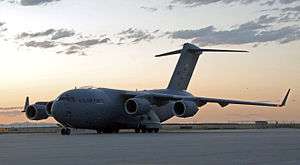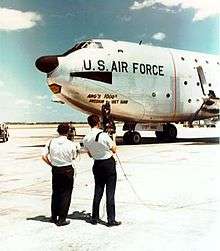183d Airlift Squadron
The 183d Airlift Squadron is a unit of the 172d Airlift Wing of the Mississippi Air National Guard, stationed at Allen C. Thompson Field Air National Guard Base, Mississippi. If activated to federal service, the Wing is gained by the United States Air Force Air Mobility Command.
| 183d Airlift Squadron | |
|---|---|
 C-17 Globemaster III from the 183d Airlift Squadron | |
| Active | July 1, 1953 – present |
| Country | |
| Allegiance | |
| Branch | |
| Type | Squadron |
| Role | Airlift |
| Part of | Mississippi Air National Guard |
| Garrison/HQ | Allen C. Thompson ANGB Field, Jackson, Mississippi |
| Nickname(s) | Flying Jumbos |
| Tail Code | Blue tail stripe, "Mississippi" in yellow letters |
| Decorations | Air Force Outstanding Unit Award |
| Insignia | |
| 183rd Airlift Squadron emblem |  |
Its mission is to provide airlift and supporting units; provide for the airlift of troops and passengers, military equipment, cargo and aeromedical airlift and to participate in operations involving the airland or airdrop of troops, equipment and supplies when required.
It was called to federal service during the first Gulf War. The 183rd was the first Air National Guard unit to convert to the C-17 Globemaster III.[1]
History
Reconnaissance
The squadron was constituted as the 183d Tactical Reconnaissance Squadron in 1953 and allotted to the Air National Guard. It was organized at Hawkins Field, Mississippi and extended federal recognition on 1 July 1953. The squadron was assigned to the 117th Tactical Reconnaissance Group, of the Alabama Air National Guard, but operational control was exercised by the Mississippi Air National Guard.[2]
The 183d was initially equipped with World War II-era Douglas RB-26C Invader night photographic reconnaissance aircraft. The black RB-26s were light bombers that were modified for aerial reconnaissance in the late 1940s. Most of the aircraft received were unarmed Korean War veterans, which carried cameras and flash flares for night aerial photography. Upon mobilization, the squadron would be gained by Tactical Air Command (TAC).
Strategic airlift


In 1957, the B-26 was reaching the end of its operational service. The squadron's mobilization gaining command became Military Air Transport Service when it was redesignated the 183d Aeromedical Transport Squadron and was equipped with Fairchild C-119 Flying Boxcar[2] transports configured for medical transport and reassigned to the 106th Aeromedical Transport Group. Five years later the unit was upgraded with the Lockheed C-121 Constellation long-range transport in 1962, becoming the 183d Air Transport Squadron and beginning to carry personnel to overseas locations in Europe and the Caribbean. The 183d and its support elements expanded into a group level later that year, when the 172d Air Transport Group was activated. The 183d became the group's flying squadron. Support elements assigned into the group were the 183d Material Squadron, 183d Air Base Squadron, and the 183d USAF Dispensary. The squadron moved from Hawkins to Allen C. Thompson Field, another field near Jackson, Mississippi in 1963.[2]
The group received the Douglas C-124 Globemaster II heavy intercontinental transport was received in 1966 which meant supplies and equipment could be carried around the world along with personnel.[2] 1966 was also marked by a change of mobilization command to Military Airlift Command (MAC) and the name to 183d Military Airlift Squadron[2]
Theater airlift
The C-124 was being retired in the early 1970s and the 183d was realigned to a theater transport mission, and equipped with Lockheed C-130E Hercules aircraft as the 183d Tactical Airlift Squadron in May 1972. Once more, TAC gained the unit if it was called to federal service. It was upgraded to new 1979 production C-130H aircraft from 1980 and continued to fly tactical airlift missions until the mid-1980s.
Return to strategic airlift
On 12 July 1986 the first Lockheed C-141B Starlifter to be released from the active duty Air Force was assigned to the Mississippi Air National Guard. With a total of eight aircraft, the unit resumed a global airlift mission and was gained by MAC when mobilized.[2]
In March 1988 the squadron took part in the airlift of approximately 3200 troops and almost 1000 tons of cargo on an exercise to Palmerola Air Base, Honduras. The 183d was the only Air National Guard unit to participate in this airlift of troops to Honduras. On 6 December 1988 the Soviet Republic of Armenia suffered a powerful earthquake. The first Air Guard aircraft to fly to Armenia was a C-141B from the 183d. Before relief missions to Armenia ended, the unit would fly six missions with its planes and crew and additionally would furnish a crew to fly a United States Air Force C-141 whose crew had reached the maximum flying hours permitted without rest. In September 1989 a devastating hurricane struck the tiny island of St. Croix, leaving the island crippled, the squadron flew eleven emergency relief missions to St. Croix, hauling 465 tons of cargo and 472 passengers.[2]
From 20 December 1989 to 12 January 1990 the 183d flew 21 sorties in support of Operation Just Cause, the operation to replace Manuel Noriega with a democratically elected government in Panama. The unit transported 403.6 tons of cargo and 1,274 passengers during the operation. On 7 August 1990 the 172d's support of Operation Desert Shield and Desert Storm began when Approximately 98 aircrew members began flying voluntary missions.[3] On 24 August 1990 the 183d Airlift Squadron was one of the first two units to be called into active federal service and moved to Charleston Air Force Base, South Carolina. Until May 1991, shen the squadron was returned to state control the 148 members of the 183d flew 2,880 sorties which transported 15,837 passengers and 25,949.2 tons of cargo.[2]
In 2000, the squadron received the C-141C with an electronic "glass cockpit". In October 2000 after the USS Cole bombing in Yemen, seventeen members of the unit and the 183d Aeromedical Evacuation Squadron deployed to Ramstein Air Base Germany. They picked up four injured sailors from Ramstein and flew them to Norfolk Naval Station, Virginia. In February 2003 the 183d retired its last Starlifter in preparation for the arrival of the wing's first Boeing C-17 Globemaster III.[2]
On 17 December 2003, Lt. Gen. Daniel James III, Director, Air National Guard, handed off the "keys" of the first C-17 Globemaster III (S/N 02-1112) to Maj. Gen. James H. Lipscomb III, adjutant general of the Mississippi National Guard. This plane was also the first Globemaster III assigned to the Air National Guard and was named the "Spirit of the Minutemen".[2]
Lineage
- Constituted as the 183d Tactical Reconnaissance Squadron Night Photographic and allotted to the National Guard in 1953
- Activated and extended federal recognition on 1 July 1953
- Redesignated 183d Aeromedical Transport Squadron, Light on 1 July 1957
- Redesignated 183d Air Transport Squadron, Heavy on 1 July 1962
- Redesignated 183d Military Airlift Squadron on 1 January 1966
- Redesignated 183d Tactical Airlift Squadron on 1 May 1972
- Redesignated 183d Military Airlift Squadron on 1 July 1986
- Federalized and placed on active duty on 24 August 1990
- Released from active duty and returned to Mississippi state control on 30 May 1991
- Redesignated 183d Airlift Squadron on 16 March 1992
Assignments
- 117th Tactical Reconnaissance Group, 1 July 1953
- 106th Aeromedical Transport Group, 1 July 1957
- 118th Air Transport Wing 1 January 1963
- 172d Air Transport Group (later 172d Military Airlift Group, 172d Tactical Airlift Group, 172d Military Airlift Group), 10 December 1963
- 315th Military Airlift Wing, 24 August 1990
- 172d Military Airlift Group (later 172d Airlift Group), 30 May 1991
- 172d Operations Group, 1 October 1995 – Present
Stations
- Hawkins Field, Mississippi, 1 July 1953
- Allen C. Thompson Field, Jackson, Mississippi, c. 10 December 1963
- Charleston Air Force Base, South Carolina, 24 August 1990
- Allen C. Thompson Field (later Allen C. Thompson Field Air National Guard Base, Mississippi, 30 May 1991 – present
Aircraft
- Douglas RB-26C Invader, 1953-1957
- Fairchild C-119 Flying Boxcar, 1957-1962
- Lockheed C-121 Constellation, 1962-1966
- Douglas C-124C Globemaster II, 1966-1972
- Lockheed C-130E Hercules, 1972-1980
- Lockheed C-130H Hercules, 1980-1986
- Lockheed C-141B Starlifter, 1986-2000
- C-141C Starlifter, 2000-2004
- Boeing C-17 Globemaster III, 2004–Present
Decorations
- 12 time recipient of the Air Force Outstanding Unit Award[4]
References
Notes
- Phot taken in South Vietnam on the occasion of the 1,000th Air National Guard flight to Vietnam.
Citations
- "Boeing Delivers First C-17 to Mississippi Air National Guard". Retrieved 19 March 2020.
- "172ND AIRLIFT WING (ANG) / 183RD AIRLIFT SQDN (ANG)". Retrieved 19 March 2020.
- "172nd Airlift Wing". Retrieved 19 March 2020.
- Air Force Personnel Center Awards Search (Post-1991) Archived 2 September 2011 at the Wayback Machine
Bibliography
![]()
- Rogers, Brian. (2005). United States Air Force Unit Designations Since 1978. Hinkley, UK: Midland Publications. ISBN 1-85780-197-0.
- Rosenfeld, Susan; Gross, Charles J. (2007). Air National Guard at 60: A History (PDF). Bolling AFB, DC: Air National Guard History Office. Archived from the original (PDF) on 13 February 2016. Retrieved 20 September 2015.

